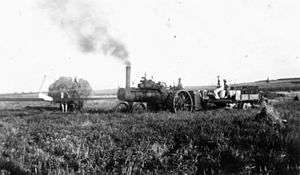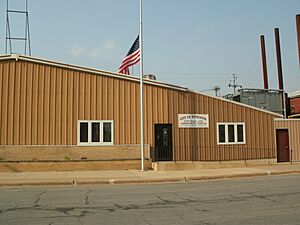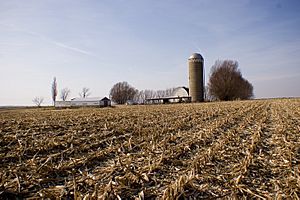Hopkinton, Iowa facts for kids
Quick facts for kids
Hopkinton, Iowa
|
|
|---|---|
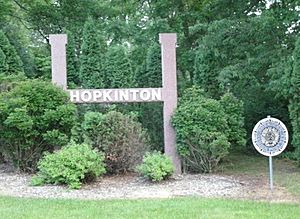
Welcome sign on Iowa Highway 38 (2010)
|
|
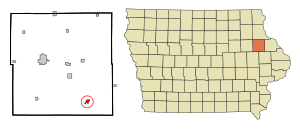
Location within Delaware County and Iowa
|
|
| Country | United States |
| State | Iowa |
| County | Delaware |
| Incorporated | March 3, 1874 |
| Area | |
| • Total | 0.64 sq mi (1.66 km2) |
| • Land | 0.64 sq mi (1.66 km2) |
| • Water | 0.00 sq mi (0.00 km2) |
| Elevation | 860 ft (260 m) |
| Population
(2020)
|
|
| • Total | 622 |
| • Density | 968.85/sq mi (374.02/km2) |
| Time zone | UTC-6 (Central (CST)) |
| • Summer (DST) | UTC-5 (CDT) |
| ZIP code |
52237
|
| Area code | 563 |
| FIPS code | 19-37155 |
| GNIS feature ID | 0457659 |
Hopkinton is a small city in Delaware County, Iowa, United States. In 2020, about 622 people lived there. It is a friendly community with a rich past.
Contents
History of Hopkinton
Hopkinton was first planned out in 1850. It officially became a city in 1874.
The city was once home to Lenox College. This was a small school that closed in 1944. Today, the old campus is kept up as the Delaware County Historical Museum Complex. This museum helps people learn about the area's history.
Geography of Hopkinton
Hopkinton is located at 42.3438857 degrees North and -91.2484799 degrees West. It is found near the Maquoketa River.
The city covers a total area of about 0.62 square miles (1.6 square kilometers). All of this area is land, with no large bodies of water inside the city limits.
People of Hopkinton: Demographics
| Historical population | |||
|---|---|---|---|
| Census | Pop. | %± | |
| 1880 | 645 | — | |
| 1890 | 668 | 3.6% | |
| 1900 | 767 | 14.8% | |
| 1910 | 797 | 3.9% | |
| 1920 | 759 | −4.8% | |
| 1930 | 758 | −0.1% | |
| 1940 | 841 | 10.9% | |
| 1950 | 731 | −13.1% | |
| 1960 | 768 | 5.1% | |
| 1970 | 800 | 4.2% | |
| 1980 | 774 | −3.2% | |
| 1990 | 695 | −10.2% | |
| 2000 | 681 | −2.0% | |
| 2010 | 628 | −7.8% | |
| 2020 | 622 | −1.0% | |
| U.S. Decennial Census | |||
Population in 2020
In 2020, there were 622 people living in Hopkinton. These people lived in 261 households. About 167 of these households were families.
The city had about 968.7 people per square mile. Most residents, about 93.6%, were White. A small number of people were from other racial backgrounds.
About 30.3% of households had children under 18 living with them. The average age in the city was 39.5 years old. About 28.3% of residents were under 20 years old.
Population in 2010
In 2010, Hopkinton had 628 people living there. There were 266 households in the city.
About 30.8% of households had children under 18. The average age of people in the city was 43.8 years. About 24% of residents were under 18 years old.
Education in Hopkinton
The Maquoketa Valley Community School District runs the public schools in the Hopkinton area. These schools provide education for local students.
Notable People from Hopkinton
- Charles Merriam (1874–1953) was a professor at the University of Chicago. He studied political science and helped shape how we understand politics today. He also advised several U.S. Presidents.
- Frank Merriam (1865–1955) was a politician. He served as the 28th governor of California. He also worked in the state governments of both Iowa and California.
- John Merriam (1869–1945) was a paleontologist, which means he studied ancient life forms like fossils. He was also an educator and worked to protect nature. He is famous for studying fossils found at the La Brea Tar Pits in Los Angeles.
See also
 In Spanish: Hopkinton (Iowa) para niños
In Spanish: Hopkinton (Iowa) para niños


